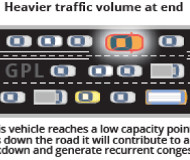12/20/2017
Report Finds Washington Toll Road Experiment A FailureOfficial analysis of Washington state toll lane experiment shows it has failed to meet statutory requirements.

The official performance analysis of the Interstate 405 toll lane project in Washington state documented how converting existing lanes into pay lanes has failed to live up to its promise. The University of Minnesota's civil engineering department tracked objective performance measures outlined in state law and released the results earlier this month.
"The $10 maximum toll was predicted to be rare, but by December of 2015, drivers paid $10 more frequently than expected," the report found. "Delays actually worsened on weekends and afternoon commutes going north through Bothell."
Optimistic projections were used to promote the tolling experiment, which the legislature authorized in 2011. The lanes opened in 2015 and the projections quickly fell short of reality. State law says the project must be shut down.
"If after two years of operation on the express toll lanes on Interstate 405 performance measures listed in subsection (4)(a) and (e) of this section are not being met, the express toll lanes project must be terminated as soon as practicable," Revised Code of Washington 47.56.880 states.
The key measures are whether the toll lanes maintain 45 MPH speeds for 90 percent of the time during peak hours, and whether the tolls collected pay for the significant costs of collection. The Washington State Department of Transportation (WSDOT) reports that the lanes are indeed profitable, but the promised "congestion management" features are falling well short of the mark.
"The I-405 Express Toll Lanes facility is not meeting the second primary performance measure the Washington legislature set for the facility," the report concluded. "This study finds that on average the amount of time in peak period where Express Toll Lanes speed is above the 45 mph statutory goal is 85 percent in the northbound direction and 78 percent in the southbound direction."
Despite the promise that the imposing tolls on the existing lanes would provide relief for commuters in the free, general purpose lanes, the data show congestion is just as bad as before tolling was imposed. The only improvement was found when capacity was added by allowing use of the shoulder.
Despite the failure to meet the statutory benchmark, the report notes that the conversion of high occupancy vehicle (HOV) carpool lanes into high occupancy toll (HOT) lanes increased overall throughput by 11 percent, as more people were able to use the road. The same figures also show that each general purpose lane carries 61 percent more traffic than a tolled lane.
To improve travel speeds for those who pay, the report recommends removing the $10 cap on tolls. In Virginia, the Interstate 66 toll road project opened earlier this month with one-way tolls as high as $44 for the ten-mile journey. The WSDOT-sponsored report also recommends the use of "segment pricing" that would allow a motorist to enter the toll lane expecting to pay one price, only to find the charge has increased in the middle of the trip. The report favors extending the rush hour commuting time by an hour, so that cars with two people on board would be charged between 9am and 10am.
A copy of the report is available in a 5mb PDF file at the source link below.


